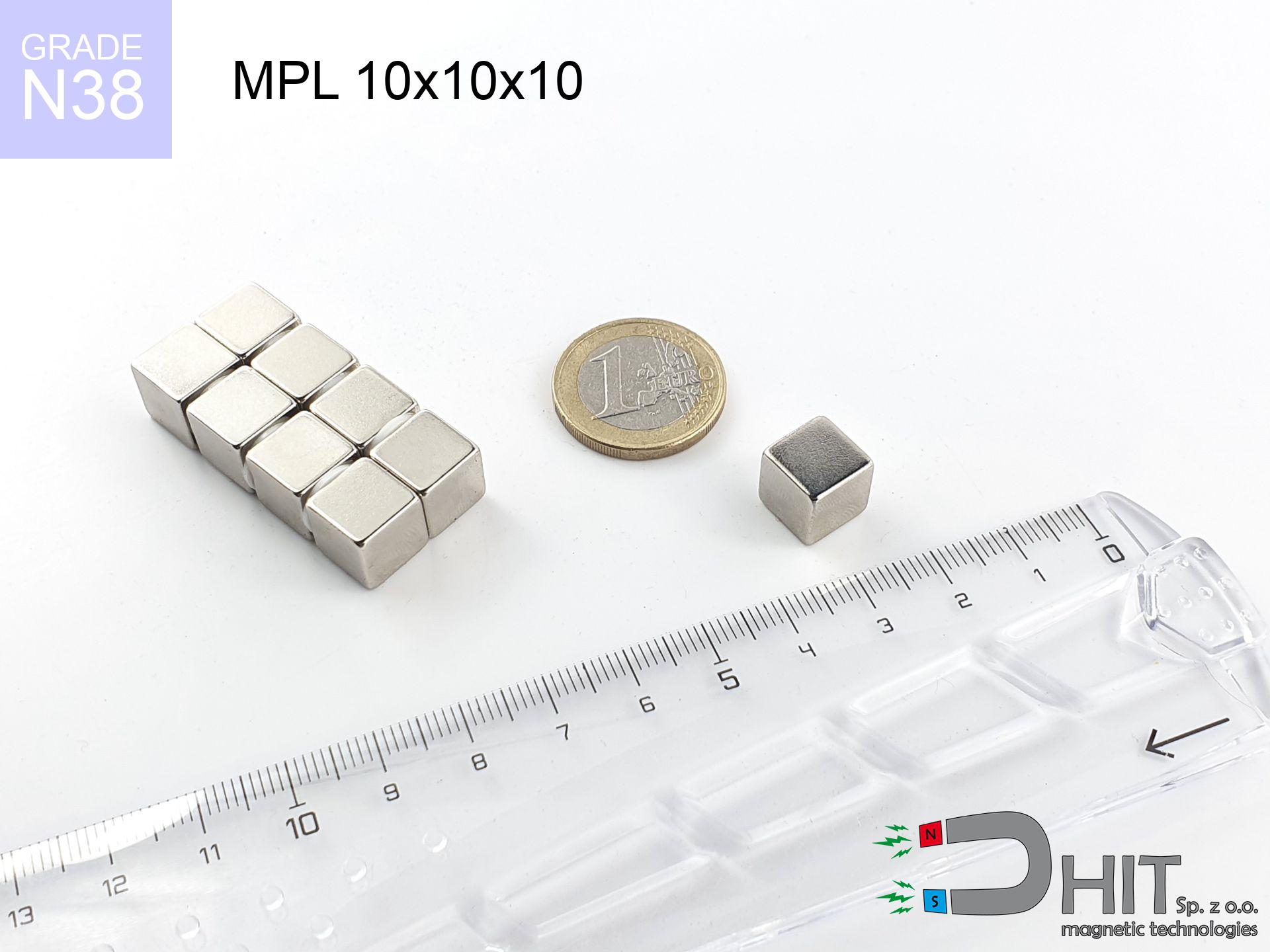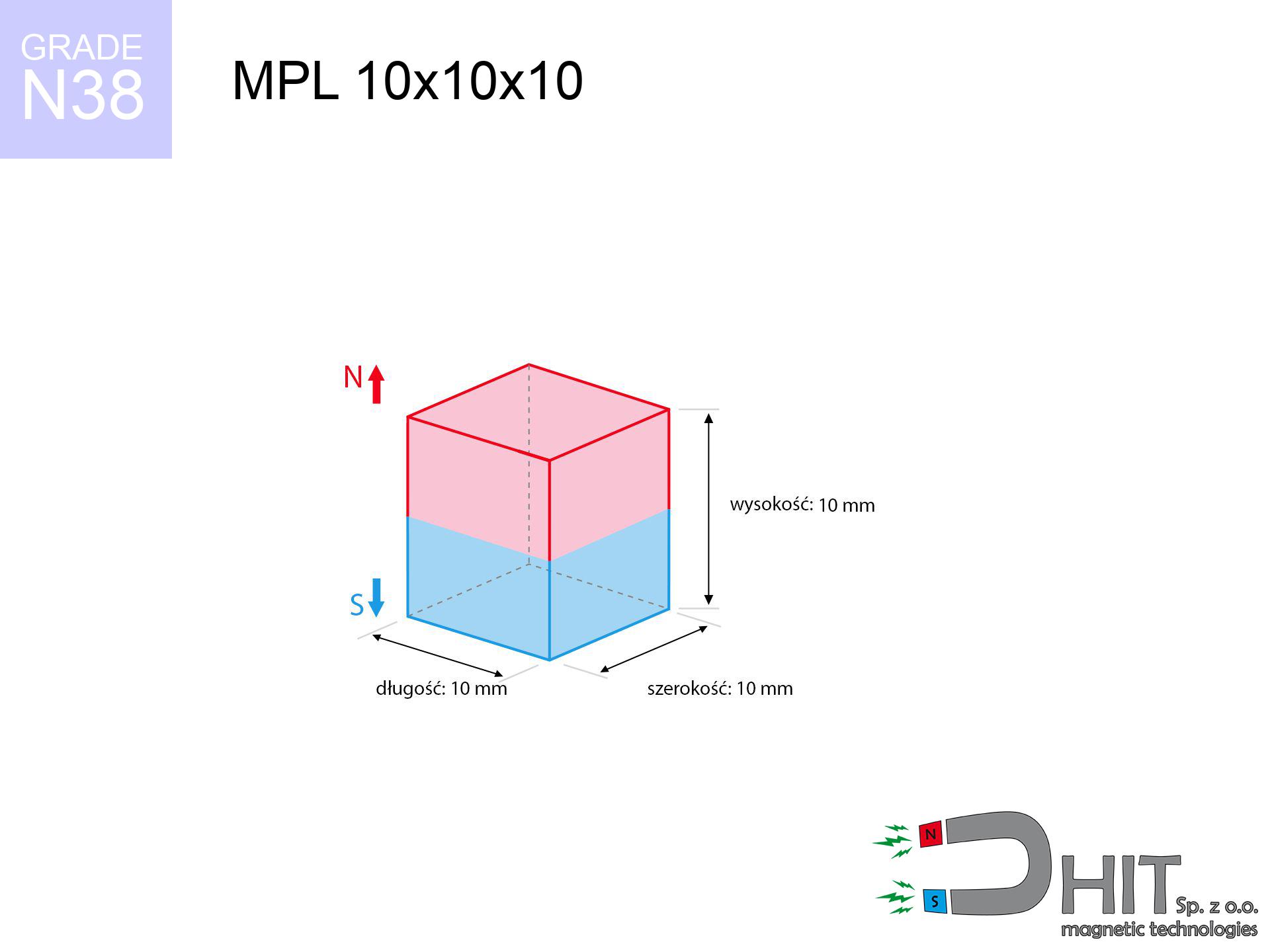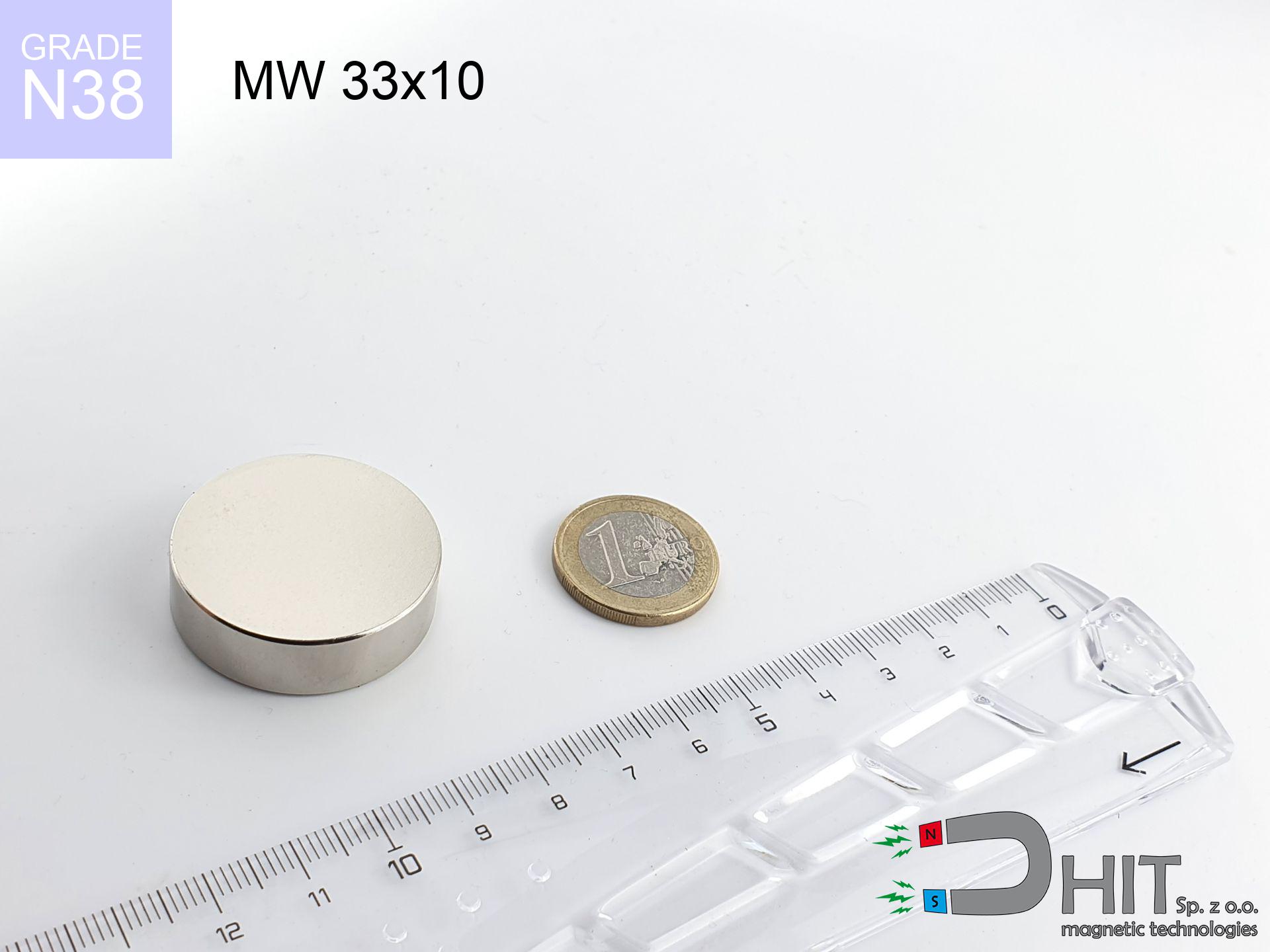MPL 10x10x10 / N38 - lamellar magnet
lamellar magnet
Catalog no 020110
GTIN/EAN: 5906301811169
length
10 mm [±0,1 mm]
Width
10 mm [±0,1 mm]
Height
10 mm [±0,1 mm]
Weight
7.5 g
Magnetization Direction
↑ axial
Load capacity
3.84 kg / 37.71 N
Magnetic Induction
539.91 mT / 5399 Gs
Coating
[NiCuNi] Nickel
5.29 ZŁ with VAT / pcs + price for transport
4.30 ZŁ net + 23% VAT / pcs
bulk discounts:
Need more?
Give us a call
+48 22 499 98 98
or let us know via
form
the contact section.
Strength along with appearance of a neodymium magnet can be tested on our
force calculator.
Orders submitted before 14:00 will be dispatched today!
Technical specification of the product - MPL 10x10x10 / N38 - lamellar magnet
Specification / characteristics - MPL 10x10x10 / N38 - lamellar magnet
| properties | values |
|---|---|
| Cat. no. | 020110 |
| GTIN/EAN | 5906301811169 |
| Production/Distribution | Dhit sp. z o.o. |
| Country of origin | Poland / China / Germany |
| Customs code | 85059029 |
| length | 10 mm [±0,1 mm] |
| Width | 10 mm [±0,1 mm] |
| Height | 10 mm [±0,1 mm] |
| Weight | 7.5 g |
| Magnetization Direction | ↑ axial |
| Load capacity ~ ? | 3.84 kg / 37.71 N |
| Magnetic Induction ~ ? | 539.91 mT / 5399 Gs |
| Coating | [NiCuNi] Nickel |
| Manufacturing Tolerance | ±0.1 mm |
Magnetic properties of material N38
| properties | values | units |
|---|---|---|
| remenance Br [min. - max.] ? | 12.2-12.6 | kGs |
| remenance Br [min. - max.] ? | 1220-1260 | mT |
| coercivity bHc ? | 10.8-11.5 | kOe |
| coercivity bHc ? | 860-915 | kA/m |
| actual internal force iHc | ≥ 12 | kOe |
| actual internal force iHc | ≥ 955 | kA/m |
| energy density [min. - max.] ? | 36-38 | BH max MGOe |
| energy density [min. - max.] ? | 287-303 | BH max KJ/m |
| max. temperature ? | ≤ 80 | °C |
Physical properties of sintered neodymium magnets Nd2Fe14B at 20°C
| properties | values | units |
|---|---|---|
| Vickers hardness | ≥550 | Hv |
| Density | ≥7.4 | g/cm3 |
| Curie Temperature TC | 312 - 380 | °C |
| Curie Temperature TF | 593 - 716 | °F |
| Specific resistance | 150 | μΩ⋅cm |
| Bending strength | 250 | MPa |
| Compressive strength | 1000~1100 | MPa |
| Thermal expansion parallel (∥) to orientation (M) | (3-4) x 10-6 | °C-1 |
| Thermal expansion perpendicular (⊥) to orientation (M) | -(1-3) x 10-6 | °C-1 |
| Young's modulus | 1.7 x 104 | kg/mm² |
Physical modeling of the product - technical parameters
The following information represent the result of a engineering simulation. Results are based on algorithms for the material Nd2Fe14B. Real-world conditions may differ. Treat these data as a supplementary guide during assembly planning.
Table 1: Static force (pull vs gap) - power drop
MPL 10x10x10 / N38
| Distance (mm) | Induction (Gauss) / mT | Pull Force (kg) | Risk Status |
|---|---|---|---|
| 0 mm |
5395 Gs
539.5 mT
|
3.84 kg / 3840.0 g
37.7 N
|
strong |
| 1 mm |
4423 Gs
442.3 mT
|
2.58 kg / 2580.1 g
25.3 N
|
strong |
| 2 mm |
3516 Gs
351.6 mT
|
1.63 kg / 1631.0 g
16.0 N
|
weak grip |
| 3 mm |
2751 Gs
275.1 mT
|
1.00 kg / 998.0 g
9.8 N
|
weak grip |
| 5 mm |
1671 Gs
167.1 mT
|
0.37 kg / 368.5 g
3.6 N
|
weak grip |
| 10 mm |
562 Gs
56.2 mT
|
0.04 kg / 41.7 g
0.4 N
|
weak grip |
| 15 mm |
244 Gs
24.4 mT
|
0.01 kg / 7.8 g
0.1 N
|
weak grip |
| 20 mm |
126 Gs
12.6 mT
|
0.00 kg / 2.1 g
0.0 N
|
weak grip |
| 30 mm |
46 Gs
4.6 mT
|
0.00 kg / 0.3 g
0.0 N
|
weak grip |
| 50 mm |
12 Gs
1.2 mT
|
0.00 kg / 0.0 g
0.0 N
|
weak grip |
Table 2: Slippage hold (wall)
MPL 10x10x10 / N38
| Distance (mm) | Friction coefficient | Pull Force (kg) |
|---|---|---|
| 0 mm | Stal (~0.2) |
0.77 kg / 768.0 g
7.5 N
|
| 1 mm | Stal (~0.2) |
0.52 kg / 516.0 g
5.1 N
|
| 2 mm | Stal (~0.2) |
0.33 kg / 326.0 g
3.2 N
|
| 3 mm | Stal (~0.2) |
0.20 kg / 200.0 g
2.0 N
|
| 5 mm | Stal (~0.2) |
0.07 kg / 74.0 g
0.7 N
|
| 10 mm | Stal (~0.2) |
0.01 kg / 8.0 g
0.1 N
|
| 15 mm | Stal (~0.2) |
0.00 kg / 2.0 g
0.0 N
|
| 20 mm | Stal (~0.2) |
0.00 kg / 0.0 g
0.0 N
|
| 30 mm | Stal (~0.2) |
0.00 kg / 0.0 g
0.0 N
|
| 50 mm | Stal (~0.2) |
0.00 kg / 0.0 g
0.0 N
|
Table 3: Wall mounting (shearing) - vertical pull
MPL 10x10x10 / N38
| Surface type | Friction coefficient / % Mocy | Max load (kg) |
|---|---|---|
| Raw steel |
µ = 0.3
30% Nominalnej Siły
|
1.15 kg / 1152.0 g
11.3 N
|
| Painted steel (standard) |
µ = 0.2
20% Nominalnej Siły
|
0.77 kg / 768.0 g
7.5 N
|
| Oily/slippery steel |
µ = 0.1
10% Nominalnej Siły
|
0.38 kg / 384.0 g
3.8 N
|
| Magnet with anti-slip rubber |
µ = 0.5
50% Nominalnej Siły
|
1.92 kg / 1920.0 g
18.8 N
|
Table 4: Material efficiency (saturation) - sheet metal selection
MPL 10x10x10 / N38
| Steel thickness (mm) | % power | Real pull force (kg) |
|---|---|---|
| 0.5 mm |
|
0.38 kg / 384.0 g
3.8 N
|
| 1 mm |
|
0.96 kg / 960.0 g
9.4 N
|
| 2 mm |
|
1.92 kg / 1920.0 g
18.8 N
|
| 5 mm |
|
3.84 kg / 3840.0 g
37.7 N
|
| 10 mm |
|
3.84 kg / 3840.0 g
37.7 N
|
Table 5: Working in heat (stability) - power drop
MPL 10x10x10 / N38
| Ambient temp. (°C) | Power loss | Remaining pull | Status |
|---|---|---|---|
| 20 °C | 0.0% |
3.84 kg / 3840.0 g
37.7 N
|
OK |
| 40 °C | -2.2% |
3.76 kg / 3755.5 g
36.8 N
|
OK |
| 60 °C | -4.4% |
3.67 kg / 3671.0 g
36.0 N
|
OK |
| 80 °C | -6.6% |
3.59 kg / 3586.6 g
35.2 N
|
|
| 100 °C | -28.8% |
2.73 kg / 2734.1 g
26.8 N
|
Table 6: Two magnets (attraction) - forces in the system
MPL 10x10x10 / N38
| Gap (mm) | Attraction (kg) (N-S) | Repulsion (kg) (N-N) |
|---|---|---|
| 0 mm |
17.95 kg / 17946 g
176.1 N
5 957 Gs
|
N/A |
| 1 mm |
14.86 kg / 14865 g
145.8 N
9 821 Gs
|
13.38 kg / 13378 g
131.2 N
~0 Gs
|
| 2 mm |
12.06 kg / 12058 g
118.3 N
8 845 Gs
|
10.85 kg / 10852 g
106.5 N
~0 Gs
|
| 3 mm |
9.64 kg / 9641 g
94.6 N
7 909 Gs
|
8.68 kg / 8677 g
85.1 N
~0 Gs
|
| 5 mm |
5.98 kg / 5978 g
58.6 N
6 228 Gs
|
5.38 kg / 5380 g
52.8 N
~0 Gs
|
| 10 mm |
1.72 kg / 1722 g
16.9 N
3 343 Gs
|
1.55 kg / 1550 g
15.2 N
~0 Gs
|
| 20 mm |
0.20 kg / 195 g
1.9 N
1 125 Gs
|
0.18 kg / 176 g
1.7 N
~0 Gs
|
| 50 mm |
0.00 kg / 3 g
0.0 N
146 Gs
|
0.00 kg / 0 g
0.0 N
~0 Gs
|
Table 7: Protective zones (electronics) - precautionary measures
MPL 10x10x10 / N38
| Object / Device | Limit (Gauss) / mT | Safe distance |
|---|---|---|
| Pacemaker | 5 Gs (0.5 mT) | 7.0 cm |
| Hearing aid | 10 Gs (1.0 mT) | 5.5 cm |
| Mechanical watch | 20 Gs (2.0 mT) | 4.5 cm |
| Phone / Smartphone | 40 Gs (4.0 mT) | 3.5 cm |
| Car key | 50 Gs (5.0 mT) | 3.0 cm |
| Payment card | 400 Gs (40.0 mT) | 1.5 cm |
| HDD hard drive | 600 Gs (60.0 mT) | 1.0 cm |
Table 8: Dynamics (cracking risk) - warning
MPL 10x10x10 / N38
| Start from (mm) | Speed (km/h) | Energy (J) | Predicted outcome |
|---|---|---|---|
| 10 mm |
22.97 km/h
(6.38 m/s)
|
0.15 J | |
| 30 mm |
39.53 km/h
(10.98 m/s)
|
0.45 J | |
| 50 mm |
51.03 km/h
(14.17 m/s)
|
0.75 J | |
| 100 mm |
72.16 km/h
(20.05 m/s)
|
1.51 J |
Table 9: Coating parameters (durability)
MPL 10x10x10 / N38
| Technical parameter | Value / Description |
|---|---|
| Coating type | [NiCuNi] Nickel |
| Layer structure | Nickel - Copper - Nickel |
| Layer thickness | 10-20 µm |
| Salt spray test (SST) ? | 24 h |
| Recommended environment | Indoors only (dry) |
Table 10: Electrical data (Flux)
MPL 10x10x10 / N38
| Parameter | Value | SI Unit / Description |
|---|---|---|
| Magnetic Flux | 5 504 Mx | 55.0 µWb |
| Pc Coefficient | 0.84 | High (Stable) |
Table 11: Submerged application
MPL 10x10x10 / N38
| Environment | Effective steel pull | Effect |
|---|---|---|
| Air (land) | 3.84 kg | Standard |
| Water (riverbed) |
4.40 kg
(+0.56 kg Buoyancy gain)
|
+14.5% |
1. Shear force
*Caution: On a vertical surface, the magnet holds only approx. 20-30% of its nominal pull.
2. Efficiency vs thickness
*Thin steel (e.g. computer case) severely limits the holding force.
3. Temperature resistance
*For standard magnets, the safety limit is 80°C.
4. Demagnetization curve and operating point (B-H)
chart generated for the permeance coefficient Pc (Permeance Coefficient) = 0.84
This simulation demonstrates the magnetic stability of the selected magnet under specific geometric conditions. The solid red line represents the demagnetization curve (material potential), while the dashed blue line is the load line based on the magnet's geometry. The Pc (Permeance Coefficient), also known as the load line slope, is a dimensionless value that describes the relationship between the magnet's shape and its magnetic stability. The intersection of these two lines (the black dot) is the operating point — it determines the actual magnetic flux density generated by the magnet in this specific configuration. A higher Pc value means the magnet is more 'slender' (tall relative to its area), resulting in a higher operating point and better resistance to irreversible demagnetization caused by external fields or temperature. A value of 0.42 is relatively low (typical for flat magnets), meaning the operating point is closer to the 'knee' of the curve — caution is advised when operating at temperatures near the maximum limit to avoid strength loss.
Chemical composition
| iron (Fe) | 64% – 68% |
| neodymium (Nd) | 29% – 32% |
| boron (B) | 1.1% – 1.2% |
| dysprosium (Dy) | 0.5% – 2.0% |
| coating (Ni-Cu-Ni) | < 0.05% |
Sustainability
| recyclability (EoL) | 100% |
| recycled raw materials | ~10% (pre-cons) |
| carbon footprint | low / zredukowany |
| waste code (EWC) | 16 02 16 |
Other products
Advantages as well as disadvantages of rare earth magnets.
Pros
- Their strength is maintained, and after approximately ten years it drops only by ~1% (according to research),
- They possess excellent resistance to magnetic field loss due to external fields,
- In other words, due to the shiny layer of gold, the element becomes visually attractive,
- The surface of neodymium magnets generates a powerful magnetic field – this is a distinguishing feature,
- Thanks to resistance to high temperature, they are able to function (depending on the shape) even at temperatures up to 230°C and higher...
- Possibility of custom machining and optimizing to specific needs,
- Universal use in modern technologies – they are commonly used in HDD drives, drive modules, medical devices, also industrial machines.
- Thanks to efficiency per cm³, small magnets offer high operating force, with minimal size,
Weaknesses
- Brittleness is one of their disadvantages. Upon strong impact they can break. We recommend keeping them in a special holder, which not only secures them against impacts but also increases their durability
- When exposed to high temperature, neodymium magnets experience a drop in strength. Often, when the temperature exceeds 80°C, their strength decreases (depending on the size and shape of the magnet). For those who need magnets for extreme conditions, we offer [AH] versions withstanding up to 230°C
- Due to the susceptibility of magnets to corrosion in a humid environment, we suggest using waterproof magnets made of rubber, plastic or other material immune to moisture, when using outdoors
- Limited ability of producing threads in the magnet and complex forms - recommended is cover - magnetic holder.
- Potential hazard to health – tiny shards of magnets pose a threat, when accidentally swallowed, which gains importance in the context of child safety. Additionally, tiny parts of these devices are able to complicate diagnosis medical after entering the body.
- Due to complex production process, their price is higher than average,
Holding force characteristics
Maximum holding power of the magnet – what contributes to it?
- using a base made of high-permeability steel, functioning as a magnetic yoke
- possessing a thickness of min. 10 mm to ensure full flux closure
- characterized by smoothness
- under conditions of ideal adhesion (metal-to-metal)
- during pulling in a direction vertical to the plane
- at standard ambient temperature
Determinants of practical lifting force of a magnet
- Clearance – the presence of foreign body (paint, dirt, gap) interrupts the magnetic circuit, which lowers capacity steeply (even by 50% at 0.5 mm).
- Pull-off angle – note that the magnet holds strongest perpendicularly. Under sliding down, the capacity drops significantly, often to levels of 20-30% of the nominal value.
- Substrate thickness – to utilize 100% power, the steel must be adequately massive. Thin sheet restricts the attraction force (the magnet "punches through" it).
- Material composition – not every steel reacts the same. High carbon content worsen the attraction effect.
- Plate texture – smooth surfaces guarantee perfect abutment, which increases field saturation. Uneven metal reduce efficiency.
- Thermal environment – temperature increase results in weakening of force. It is worth remembering the thermal limit for a given model.
Lifting capacity testing was performed on plates with a smooth surface of suitable thickness, under a perpendicular pulling force, in contrast under parallel forces the load capacity is reduced by as much as fivefold. Moreover, even a small distance between the magnet and the plate lowers the holding force.
Safe handling of NdFeB magnets
Impact on smartphones
Be aware: rare earth magnets produce a field that interferes with precision electronics. Maintain a separation from your phone, device, and GPS.
Dust explosion hazard
Powder produced during machining of magnets is flammable. Avoid drilling into magnets unless you are an expert.
Data carriers
Avoid bringing magnets near a wallet, computer, or TV. The magnetic field can irreversibly ruin these devices and wipe information from cards.
Bone fractures
Watch your fingers. Two powerful magnets will join instantly with a force of several hundred kilograms, destroying anything in their path. Be careful!
Do not give to children
Adult use only. Small elements can be swallowed, causing serious injuries. Keep away from children and animals.
Magnets are brittle
Despite the nickel coating, the material is brittle and cannot withstand shocks. Avoid impacts, as the magnet may shatter into hazardous fragments.
Skin irritation risks
Warning for allergy sufferers: The Ni-Cu-Ni coating contains nickel. If redness occurs, immediately stop handling magnets and wear gloves.
Do not underestimate power
Handle with care. Rare earth magnets act from a long distance and snap with massive power, often quicker than you can move away.
Power loss in heat
Watch the temperature. Heating the magnet above 80 degrees Celsius will destroy its magnetic structure and pulling force.
Health Danger
People with a ICD should maintain an absolute distance from magnets. The magnetic field can stop the operation of the life-saving device.








